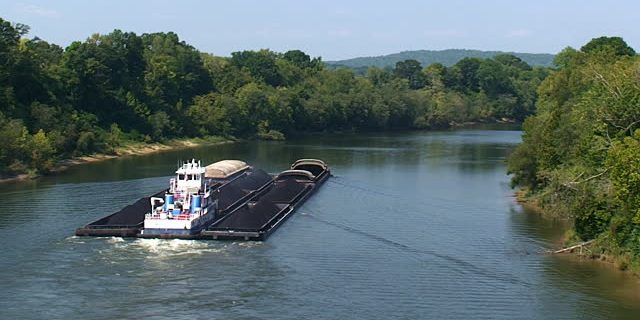MOBILE – Alabama’s inland waterways deliver coal, steel, wood pellets, ag products, petroleum and chemical products to ports up and down the state.
And, according to a study, the waterways also deliver thousands of jobs and billions of dollars in economic impact to Alabama.
The Coalition of Alabama Waterway Association said its 2025 Economic Impact Study showed the state’s commercial waterways delivered $19 billion in value in 2022.
The study found that commercial activity along Alabama’s five federally authorized waterways — the Black Warrior-Tombigbee, Tennessee-Tombigbee, Alabama, Apalachicola-Chattahoochee-Flint, and Tennessee rivers — supports one in every 24 jobs statewide.
That equates to more than 91,000 jobs across Alabama directly tied to waterway activities including cargo shipments and recreation.
“This study makes clear what we’ve long known: Alabama’s inland waterways are a powerful economic engine,” said Port Director John Driscoll of the Alabama Port Authority. “They’re not only vital to communities across the state, but they also connect seamlessly with the Port of Mobile to support global trade, manufacturing, and job growth.
“Continued investment in waterway infrastructure — both inland and coastal — is critical to sustaining and expanding Alabama’s competitive edge in domestic and international commerce.”
When combined with activity at the Port of Mobile, the total economic impact of waterborne commerce across the state rises to $113.9 billion, with $17.8 billion attributed specifically to shipping on inland waterways, the study said. Inland waterway-related commerce also contributes nearly $650 million annually in state and local tax revenues.
“Alabama’s waterways are the arteries of our economy — driving job creation, supporting our farmers and manufacturers, and strengthening our supply chains,” said U.S. Sen. Katie Britt (R-Montgomery). “This study underscores just how critical our inland waterway infrastructure is to the prosperity of every corner of our state.
“I’ll continue to be an advocate for Alabama’s expansive waterway system to ensure our industries thrive and Alabamians remain connected.“
CAWA represents five inland river associations:
- Warrior-Tombigbee Waterway Association
- Tennessee River Valley Association
- Tennessee-Tombigbee Waterway Development Authority
- Coosa-Alabama River Improvement Association
- Tri-Rivers Waterway Development Association
These organizations advocate for and represent Alabama’s major inland rivers and waterways:
- Black Warrior River (including the Locust and Mulberry Forks)
- Tennessee River
- Tombigbee River
- Tennessee-Tombigbee Waterway
- Alabama-Coosa-Tallapoosa River System
- Chattahoochee River
Wynne Fuller, president of the Warrior-Tombigbee Waterway Association, said Alabama’s inland waterways remain the only mode of freight transportation with significant untapped capacity.
“The demand to move bulk commodities such as metallurgical coal, scrap for steel, finished steel products, wood pellets, ag products, construction materials, petroleum and chemical products continues to rise,” Fuller said. “Terminals in Birmingport, Demopolis, Decatur, Columbus, and Yellow Creek are investing in infrastructure and modern material-handling equipment to meet this growing demand.”
This increased activity, along with the push to enhance transportation efficiency and regional competitiveness, is driving a Waterway Improvement Study. The study will assess the need to deepen the Black Warrior-Tombigbee and Tennessee-Tombigbee waterways — which, along with the Tennessee River, carry the majority of the state’s inland waterborne commerce.
The report also highlights renewed interest in navigation on the Apalachicola-Chattahoochee-Flint (ACF) system. With substantial federal investment through the Army Corps of Engineers to restore lock infrastructure, cargo volumes on the ACF system are expected to grow significantly.
The study also measured the economic contributions of non-industrial uses. Marinas and recreational boating account for nearly 1,700 jobs and $121.5 million in personal income. Fishing tournaments add another $18 million in economic activity annually.
Additionally, river cruise activity along the Alabama, Coosa, and Tallapoosa Rivers, as well as the Tennessee and Tenn-Tom Waterways, contributes over $24 million to the state’s tourism economy.
Martin Associates’ analysis categorized impacts into five key sectors:
- Maritime logistics and shipping
- Marinas and recreational boating
- Cruise passenger activity
- Fishing tournaments
- Ship and boat building
Martin Associates was retained by CAWA to conduct a comprehensive statewide study. The findings will be presented next week during the annual meeting of the Warrior-Tombigbee Waterway Association at the Perdido Beach Resort in Orange Beach.
Don’t miss out! Subscribe to our email newsletter to have all our smart stories delivered to your inbox.



